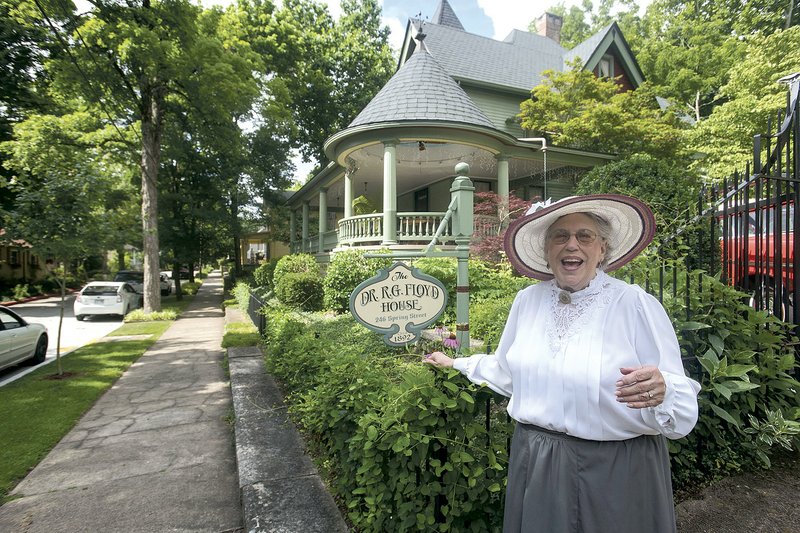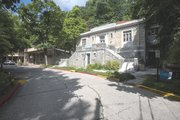Dr. Alvah Jackson discovered the "healing" springs in 1856, but history records Eureka Springs as formally founded on July 4, 1879, when Levi Best Saunders built the first house.
Saunders, a Berryville judge, tried the spring water to treat a skin disease and was himself healed, according to the Encyclopedia of Arkansas. Although Dr. Jackson had set up a well-known "cave hospital" during the Civil War, this time, the word traveled far and wide, and more people arrived every day to take advantage of the purported power of the springs.
Happy Birthday Stroll
Eureka Springs
When: 10 a.m. to 1:30 p.m. Sunday (or Monday, if rains)
Where: Starts at Eureka Springs Public Library, 194 Spring St.
Benefits: Eureka Springs Historial Museum
Tickets: $25, include box chicken dinner
Available: At the musuem, 95 Spring St., or eurekaspringhistori…
Information: (479) 253-9417
The Eureka Springs Historical Museum will celebrate the founding of the town Sunday with the "Happy Birthday Stroll." The guided walk wanders past eight historic homes on Spring Street, and a historical character in costume standing outside each home will share the history of the structure and the town. The event is a fundraiser for the museum, modeled after the popular "Voices From the Silent City" series each October in the Eureka Springs Cemetery.
The tour does not include the interiors of the homes, says Stephanie Stoddard, the museum's director of operations.
"The homeowners were asked to decorate patriotic to the period. We won't go in the homes, but these homeowners love to have their homes on display."
The tour starts at the Eureka Springs Public Library, one of four in the state funded by steel magnate Andrew Carnegie. The three-story structure was built with stone from local quarries, which was hard to cut and delayed completion of construction until 1912. A stone mason for many of the stone buildings in Eureka Springs, James M. Waldrup (played by Tim Garrison) shares some history of the early city with tour visitors.
"The early town had been built of wooden buildings that sat close together, and the town was nearly destroyed by fire twice," first in 1883 and again in 1888, Waldrup relates.
"After that, the people built back out of stone," the stone mason says. "I guess stone will last as long as the world does. It was then I started working as a stone mason."
In addition to stone buildings, 56 miles of stone walls were built by the 30 stone masons in town to stabilize bluffs and hillsides around the springs and streets. A quarry was established by the town's postmaster, Benjamin Rosewater, at Beaver Town.
"Some of these homes don't stand out," Stoddard says. "We really had to dig deeper to find out who so-and-so was that lived there." Scriptwriters relied on the museum's records for the narratives. "We want to be accurate in what we say."
The Rosalie House, 282 Spring St., was owned by Eureka Springs entrepreneur J.W. Hill, and outside it, Mae Starr Miller (played by Karen Pryor) tells his story along with hers.
Miller, born in 1874, lived on Elk Street with her husband George and daughter, Mary Susan. "I was so happy with her," Miller related. "Then ... well ... George and I divorced. In the 1920s in a small town, it wasn't easy to be a divorced single woman, raising a child."
Hill saw an opportunity carrying passengers and their luggage from the train station, up the hill to the palace-like Crescent Hotel. He expanded the operation into a livery and stables at the hotel.
"I guess Mr. Hill remembered what it was like when he was an orphan and needed a job, because he gave me a chance to help him with his next endeavour," Miller says.
Hill saw a telephone system demonstrated at the World's Columbian Exposition in 1893 in Chicago, bought a system and hired Miller as the first switchboard operator. "Mae Starr Miller kept the job of switchboard operator for 44 years," the guide says. "She retired in 1939 when Southwestern Bell offered their customers rotary dialing."
The tour ends at the Fuller home, built in 1904 by Claude Fuller, "the most accomplished politician in the history of Eureka Springs." Fuller, a Democrat, served as the mayor of Eureka Springs, the area's prosecuting attorney, a member of the State House of Representatives and the U.S. Congress. He secured convict labor to build the first highway through the mountains from Seligman, Mo., and worked on the Flood Control Act of 1938, which resulted in the Norfork, Bull Shoals, Table Rock and Beaver lakes.
"Uphill, past the historic shopping district, past the post office, is a residential area," Stoddard says. "The streets become pretty flat -- but use caution on the historic limestone sidewalks, which might be cracked. It's a half-mile comfortable walk."
The tour ends with a boxed chicken dinner and a lemonade stand, available to ticket holders.
Tickets are $25 but are limited. Tours will depart the library every 30 minutes between 10 a.m. and 1:30 p.m. Sunday, with seven tours total. Ticket buyers will join the next tour after the purchase of their tickets.
NAN Our Town on 06/30/2016



